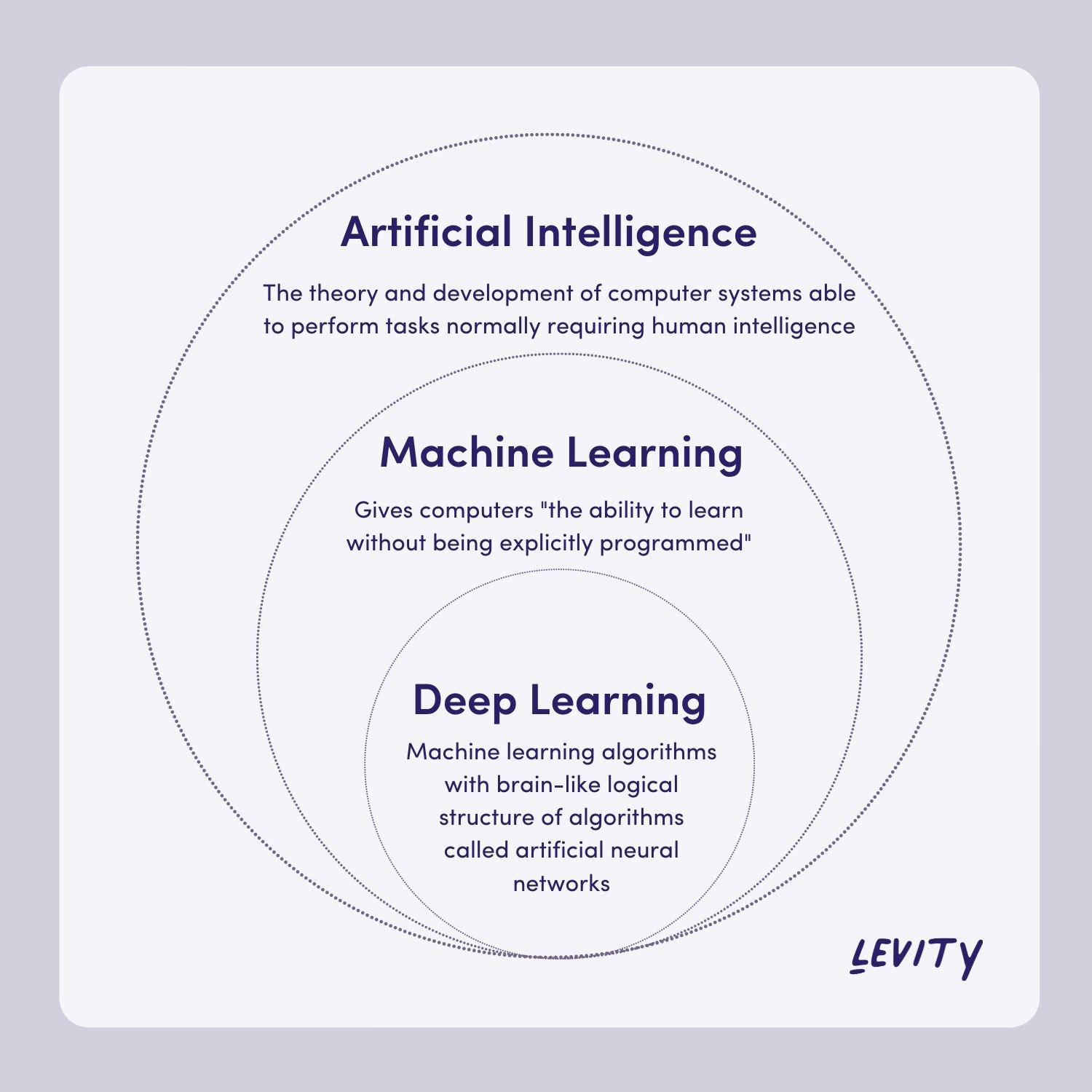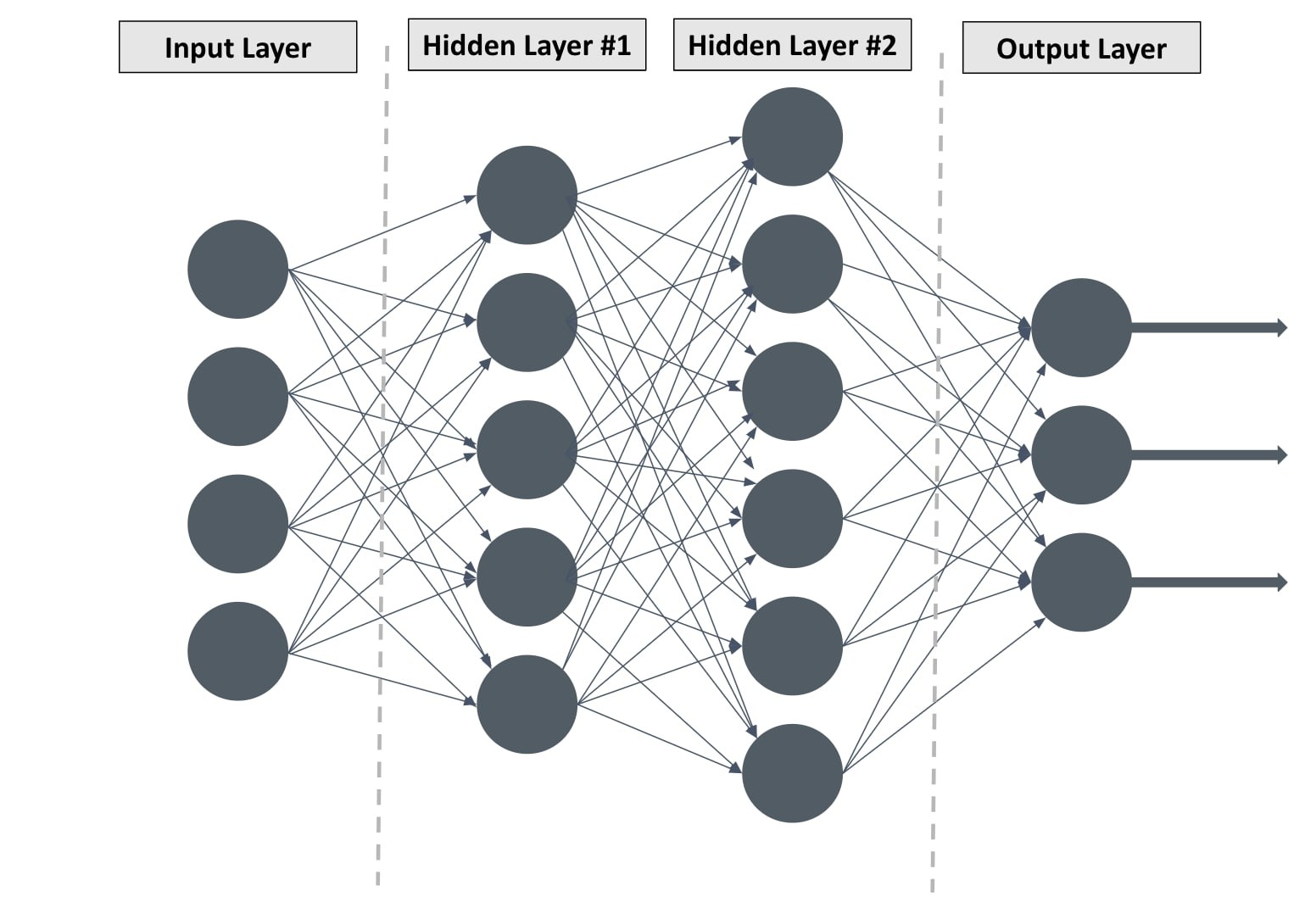Machine learning and deep learning are often used interchangeably, but understanding their distinct roles is crucial in the realm of artificial intelligence. This comprehensive guide from LEARNS.EDU.VN breaks down the core differences between these two powerful techniques, revealing how each can be leveraged to solve unique problems. Explore the nuances of algorithms, data requirements, and applications to unlock the full potential of both machine learning and its sophisticated subset, deep learning, and become proficient in AI concepts, model training, and neural network architectures.
1. Understanding the Essence of Machine Learning
Machine learning empowers computers to learn from data without explicit programming. It’s the intersection of computer science and statistics, where algorithms identify patterns and make predictions on new data. This process involves training algorithms on datasets, enabling them to adapt and improve their accuracy over time.
1.1. Supervised vs. Unsupervised Learning
Machine learning algorithms generally fall into two categories: supervised and unsupervised.
- Supervised Learning: The algorithm learns from labeled data, where the correct output is provided. This allows the algorithm to make predictions on new, unseen data. Examples include classification and regression tasks.
- Unsupervised Learning: The algorithm learns from unlabeled data, discovering hidden patterns and structures within the data. Examples include clustering and dimensionality reduction.
1.2. A Simple Machine Learning Example: Linear Regression
Consider predicting income based on years of higher education. A linear regression model can be used, defining a function such as:
income = y + x * years of education
The algorithm is then trained on data of people’s education and income, allowing it to draw a line of best fit. When new data (your own education years) is input, it predicts your income. This demonstrates the fundamental principle of machine learning: learning to make predictions based on data patterns without explicit programming.
1.3. Key Characteristics of Machine Learning
- Machine learning resides at the intersection of computer science and statistics.
- It enables computers to learn without being explicitly programmed.
- Supervised and unsupervised learning represent the two primary categories of machine learning problems.
- Machine learning algorithms can range from simple linear regressions to complex models.
2. Delving into the Depths of Deep Learning
Deep learning algorithms represent a sophisticated evolution of machine learning, capable of analyzing data with a human-like logical structure. These algorithms employ artificial neural networks (ANNs), inspired by the biological neural networks of the human brain.
2.1. The Structure of Artificial Neural Networks
ANNs consist of interconnected layers of nodes (neurons). The first layer is the input layer, the last is the output layer, and the layers in between are hidden layers. The more hidden layers, the deeper the network. Generally, ANNs with two or more hidden layers are considered deep neural networks.
2.2. Deep Learning Applications in the Real World
Deep learning is transforming various industries:
- Automated Driving: Detecting objects like stop signs and pedestrians.
- Military: Identifying objects from satellite imagery.
- Consumer Electronics: Powering home assistants like Amazon Alexa.
2.3. An Illustrative Example: Tesla’s Self-Driving Cars
Consider Tesla using deep learning to recognize STOP signs. The ANN identifies relevant features like points, edges, and shapes. Unlike traditional machine learning, deep learning allows for automatic feature engineering. The initial hidden layer detects edges, the subsequent layers differentiate colors, and the final layers recognize complex shapes specific to the object being identified. The algorithm learns from its errors, adjusting itself based on the training data.
2.4. The Role of a Neuron in an ANN
Each neuron in an ANN performs a specific task. The network can automatically learn complex patterns and relationships within data through its intricate connections and layered structure.
2.5. Factors Driving the Rise of Deep Learning
Two primary factors have contributed to the recent surge in deep learning:
- Data Availability: Deep learning requires massive datasets.
- Computing Power: Training deep learning networks demands significant computing power. The emergence of cloud computing and high-performance GPUs has dramatically reduced training times.
2.6. Transfer Learning: A Breakthrough
Transfer learning, the use of pre-trained models, addresses the need for vast training datasets. Pre-trained models can be fine-tuned for specific tasks, reducing the amount of data required for training.
2.7. Key Characteristics of Deep Learning
- Deep learning is a specialized subset of machine learning.
- It relies on artificial neural networks.
- Deep learning requires substantial data but needs minimal human intervention.
- Transfer learning mitigates the need for large training datasets.
3. Unveiling the Core Differences Between Machine Learning and Deep Learning
Deep learning is machine learning. However, what makes deep learning special? The answer lies in the ANN algorithm structure, reduced human intervention, and larger data requirements.
3.1. Algorithmic Structure
Traditional machine learning algorithms have simpler structures like linear regression or decision trees. Deep learning, on the other hand, is based on the complex, multi-layered artificial neural network.
3.2. Human Intervention
Deep learning algorithms require less human intervention. In the Tesla example, a traditional machine learning algorithm would require a software engineer to manually select features and adjust the algorithm. A deep learning algorithm automates feature extraction and learns from its own errors.
3.3. Data Requirements
Deep learning requires significantly more data than traditional machine learning. Machine learning can work with thousands of data points, while deep learning often requires millions. This is due to the complex, multi-layered structure of deep learning systems, which necessitates large datasets to eliminate fluctuations and ensure high-quality interpretations.
3.4. Comparative Analysis Table
| Feature | Machine Learning | Deep Learning |
|---|---|---|
| Algorithmic Structure | Simpler (e.g., linear regression, decision trees) | Complex (Artificial Neural Networks) |
| Human Intervention | Requires manual feature selection and adjustment | Automates feature extraction and learns from errors |
| Data Requirements | Works with smaller datasets (thousands) | Requires large datasets (millions) |
| Computation Power | Lower | Higher |
| Feature Engineering | Manual | Automatic |




4. Practical Applications and Use Cases
Both machine learning and deep learning have a wide array of applications across various industries. Understanding these applications can help you appreciate the distinct capabilities of each approach.
4.1. Machine Learning Applications
- Fraud Detection: Identifying fraudulent transactions based on historical data.
- Spam Filtering: Classifying emails as spam or not spam.
- Recommendation Systems: Suggesting products or content based on user preferences.
- Credit Scoring: Assessing the creditworthiness of loan applicants.
- Medical Diagnosis: Assisting in the diagnosis of diseases based on patient data.
4.2. Deep Learning Applications
- Image Recognition: Identifying objects and scenes in images.
- Natural Language Processing: Understanding and generating human language.
- Speech Recognition: Converting spoken language into text.
- Autonomous Vehicles: Enabling self-driving cars to navigate and make decisions.
- Drug Discovery: Accelerating the discovery of new drugs and therapies.
- Personalized Medicine: Tailoring medical treatments to individual patients.
4.3. Choosing the Right Approach
Selecting between machine learning and deep learning depends on the specific problem, the amount of available data, and the computational resources at your disposal.
- Machine Learning: Suitable for problems with smaller datasets, less complex relationships, and limited computational resources.
- Deep Learning: Ideal for problems with large datasets, complex relationships, and access to significant computational power.
5. Trends and the Future of Machine Learning and Deep Learning
The fields of machine learning and deep learning are continuously evolving, with new trends and breakthroughs emerging regularly. Staying informed about these developments is crucial for anyone seeking to leverage these technologies effectively.
5.1. Key Trends in Machine Learning
- Automated Machine Learning (AutoML): Automating the process of building and deploying machine learning models.
- Explainable AI (XAI): Developing models that are transparent and whose decisions can be easily understood.
- Federated Learning: Training models on decentralized data without sharing the data itself.
- Reinforcement Learning: Training agents to make decisions in an environment to maximize a reward.
5.2. Key Trends in Deep Learning
- Generative Adversarial Networks (GANs): Generating new data that resembles the training data.
- Transformers: Revolutionizing natural language processing and computer vision.
- Graph Neural Networks: Processing and analyzing graph-structured data.
- Self-Supervised Learning: Training models on unlabeled data by creating artificial labels.
5.3. The Future of AI Education at LEARNS.EDU.VN
At LEARNS.EDU.VN, we are committed to providing the most up-to-date and comprehensive education in machine learning and deep learning. Our courses are designed to equip you with the knowledge and skills you need to succeed in this rapidly evolving field. We are continuously updating our curriculum to reflect the latest trends and breakthroughs in AI, ensuring that our students are always at the forefront of innovation.
6. Deep Dive into Model Training
One of the most crucial aspects of both machine learning and deep learning is model training. This process involves feeding data into an algorithm so it can learn the underlying patterns and relationships. Understanding the intricacies of model training can significantly improve your ability to create effective AI solutions.
6.1. Data Preprocessing
Before any training can occur, data needs to be cleaned and preprocessed. This step is vital to ensure that the data is in a usable format and free from errors.
- Cleaning: Removing or correcting inaccurate data.
- Normalization: Scaling data to a standard range.
- Feature Selection: Choosing the most relevant features for training.
6.2. Training Algorithms
Various algorithms are used for model training. The choice of algorithm depends on the type of problem and the nature of the data.
- Linear Regression: Used for predicting continuous values.
- Logistic Regression: Used for binary classification problems.
- Decision Trees: Used for both classification and regression.
- Support Vector Machines: Used for classification and regression.
- Neural Networks: Used for complex pattern recognition.
6.3. Validation and Testing
After training, the model must be validated and tested to ensure its accuracy and reliability.
- Validation: Using a portion of the data to fine-tune the model.
- Testing: Evaluating the model on a separate dataset to assess its performance.
6.4. Hyperparameter Tuning
Hyperparameters are parameters that are set before the training process begins. Tuning these parameters can significantly impact the model’s performance.
- Grid Search: Testing all possible combinations of hyperparameters.
- Random Search: Randomly selecting combinations of hyperparameters to test.
- Bayesian Optimization: Using Bayesian methods to optimize the choice of hyperparameters.
7. Neural Network Architectures Explained
A deep understanding of neural network architectures is essential for anyone working with deep learning. This section provides an overview of the most common neural network architectures.
7.1. Feedforward Neural Networks
These are the simplest type of neural network. Data flows in one direction, from the input layer to the output layer.
- Applications: Basic classification and regression tasks.
7.2. Convolutional Neural Networks (CNNs)
CNNs are designed to process data with a grid-like topology, such as images.
- Applications: Image recognition, object detection, and video analysis.
7.3. Recurrent Neural Networks (RNNs)
RNNs are designed to process sequential data, such as text and time series.
- Applications: Natural language processing, speech recognition, and machine translation.
7.4. Transformers
Transformers have revolutionized natural language processing. They use self-attention mechanisms to weigh the importance of different parts of the input data.
- Applications: Machine translation, text summarization, and question answering.
8. The Role of Data in Machine Learning and Deep Learning
Data is the lifeblood of machine learning and deep learning. Without high-quality data, it is impossible to build effective AI models.
8.1. Data Collection
Collecting the right data is the first step in any machine learning project.
- Public Datasets: Many public datasets are available for training machine learning models.
- Web Scraping: Extracting data from websites.
- APIs: Accessing data from online services.
- Sensors: Collecting data from physical sensors.
8.2. Data Quality
The quality of the data is just as important as the quantity.
- Accuracy: Ensuring that the data is correct and free from errors.
- Completeness: Ensuring that all necessary data is present.
- Consistency: Ensuring that the data is consistent across different sources.
- Relevance: Ensuring that the data is relevant to the problem being solved.
8.3. Data Augmentation
Data augmentation is the process of creating new data from existing data. This can be useful when the amount of available data is limited.
- Image Rotation: Rotating images to create new training examples.
- Image Scaling: Scaling images to different sizes.
- Text Translation: Translating text into different languages.
- Adding Noise: Adding random noise to the data to make the model more robust.
9. Overcoming Challenges in Machine Learning and Deep Learning
While machine learning and deep learning offer tremendous potential, they also present several challenges.
9.1. Overfitting
Overfitting occurs when a model learns the training data too well and is unable to generalize to new data.
- Regularization: Adding a penalty to the model to prevent it from becoming too complex.
- Dropout: Randomly dropping out neurons during training to prevent the model from relying on any single neuron.
- Early Stopping: Stopping the training process when the model starts to overfit.
9.2. Bias
Bias occurs when the training data is not representative of the real world.
- Data Augmentation: Creating more representative training data.
- Re-weighting: Giving more weight to underrepresented data points.
- Bias Detection: Identifying and mitigating bias in the training data.
9.3. Computational Resources
Training deep learning models can require significant computational resources.
- Cloud Computing: Using cloud-based resources to train models.
- GPUs: Using GPUs to accelerate the training process.
- Distributed Training: Training models on multiple machines.
10. Ethical Considerations in Machine Learning and Deep Learning
As machine learning and deep learning become more prevalent, it is important to consider the ethical implications of these technologies.
10.1. Fairness
Ensuring that AI systems are fair and do not discriminate against any particular group.
- Bias Detection: Identifying and mitigating bias in the training data.
- Fairness Metrics: Measuring the fairness of AI systems.
- Algorithmic Transparency: Making AI systems more transparent and understandable.
10.2. Privacy
Protecting the privacy of individuals whose data is used to train AI systems.
- Data Anonymization: Removing personally identifiable information from the data.
- Differential Privacy: Adding noise to the data to protect individual privacy.
- Federated Learning: Training models on decentralized data without sharing the data itself.
10.3. Accountability
Ensuring that AI systems are accountable for their decisions.
- Explainable AI (XAI): Developing models that are transparent and whose decisions can be easily understood.
- Auditing: Regularly auditing AI systems to ensure that they are functioning properly.
- Human Oversight: Ensuring that there is human oversight of AI systems.
FAQ Section: Machine Learning vs. Deep Learning
1. What is the primary difference between machine learning and deep learning?
Deep learning is a subfield of machine learning that uses artificial neural networks with multiple layers (hence, “deep”) to analyze data. Machine learning encompasses a broader range of algorithms that allow computers to learn from data without explicit programming.
2. Which requires more data: machine learning or deep learning?
Deep learning typically requires significantly more data than traditional machine learning algorithms to achieve high performance.
3. Can deep learning be used for all machine learning tasks?
While deep learning can be applied to many machine learning tasks, it is not always the best choice. For simpler tasks with limited data, traditional machine learning algorithms may be more effective.
4. Is deep learning always more accurate than machine learning?
Not necessarily. Deep learning models can achieve higher accuracy on complex tasks with large datasets, but they may not outperform simpler machine learning models on smaller datasets or simpler problems.
5. What are some common applications of machine learning?
Common applications of machine learning include spam filtering, fraud detection, recommendation systems, and medical diagnosis.
6. What are some common applications of deep learning?
Common applications of deep learning include image recognition, natural language processing, speech recognition, and autonomous vehicles.
7. What is an artificial neural network (ANN)?
An artificial neural network is a computational model inspired by the structure and function of the human brain. It consists of interconnected nodes (neurons) arranged in layers.
8. What is transfer learning?
Transfer learning is a technique where a model trained on one task is re-used as the starting point for a model on a second task. This can significantly reduce the amount of data and training time required.
9. What are the ethical considerations in machine learning and deep learning?
Ethical considerations include fairness, privacy, and accountability. It is important to ensure that AI systems are fair, protect privacy, and are accountable for their decisions.
10. How can I learn more about machine learning and deep learning?
LEARNS.EDU.VN offers a variety of courses and resources to help you learn more about machine learning and deep learning. Visit our website to explore our offerings.
Embark on Your AI Journey with LEARNS.EDU.VN
Ready to unlock the power of machine learning and deep learning? At LEARNS.EDU.VN, we provide comprehensive resources and expert guidance to help you master these cutting-edge technologies.
Are you facing challenges in finding reliable learning materials? Do you feel lost in complex concepts or lack effective learning methods? LEARNS.EDU.VN is here to help. We offer clear, detailed guides, proven learning methods, and expert insights to simplify complex topics.
Visit LEARNS.EDU.VN today to explore our courses, discover valuable resources, and connect with our community of learners. Take the first step towards becoming an AI expert!
Contact Us:
- Address: 123 Education Way, Learnville, CA 90210, United States
- WhatsApp: +1 555-555-1212
- Website: LEARNS.EDU.VN
Join us at learns.edu.vn and transform your passion for learning into a successful future.

